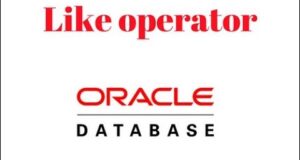REQUEST COMPLIMENTARY SQLS*PLUS LICENCE
Oracle LIKE operator

Oracle condition LIKE allows to use wildcards which will be used in WHERE operator in SELECT, INSERT, UPDATE or DELETE queries. This allows comparison with a pattern.
LIKE syntax in Oracle/PLSQL
expression LIKE pattern [ ESCAPE 'escape_character' ]
Parameters and arguments of the condition
- expression – a symbolic expression, such as a field or a column.
- pattern – A symbolic expression that contains a pattern matching. pattern that you can choose:
| wildcard symbol | explanatory note |
|---|---|
| % | Corresponds to any string of any length (including zero length) |
| _ | Meets one symbol |
- escape_character – Optional. Allows checking for literals of wildcards, such as % or _.
Example of % usage (percentage symbol)
The first Oracle example of the LIKE operator that we will look at involves the use of the % wildcard.
Let’s look at how % works in Oracle of the LIKE operator. We want to find all the customers whose last_name starts with ‘Ar’.
SELECT last_name
FROM customers
WHERE last_name LIKE 'Ap%';
You can also use multiple % characters within a single line.
For example:
SELECT last_name
FROM customers
WHERE last_name LIKE '%er%';
In this example of the Oracle LIKE operator, we search for all customers whose last_name contains ‘er’ characters.
Example of using _ (underscore character)
Next, let’s take a look at how the _ (underscore character) wildcard works in the Oracle LIKE operator. Remember that _ only looks for one character.
For example:
SELECT supplier_name
FROM suppliers
WHERE supplier_name LIKE 'Sm_th';
In this example Oracle LIKE will return all suppliers whose supplier_name is 5 characters long, where the first two characters are ‘Sm’ and the last two characters are ‘th’. For example it can return suppliers whose supplier_name is ‘Smith’, ‘Smyth’, ‘Smath’ or ‘Smeth’ etc.
Here is another example:
SELECT *
FROM suppliers
WHERE account_number LIKE '92314_';
Looking for an account number, you may find that you have only 5 of 6 digits. In the above example, potentially 10 last entries will be returned (where the missing value may be from 0 to 9). For example, a query may return a supplier whose account_number is:
923140, 923141, 923142, 923143, 923144, 923145, 923146, 923147, 923148, 923149
Example of NOT operator usage
Next, let’s look at how you will use the Oracle NOT operator with wildcards.
Let’s use % with the NOT operator. You can also use Oracle’s LIKE operator to search for suppliers (suppliers) whose names do not start with ‘W’.
For example:
SELECT supplier_name
FROM suppliers
WHERE supplier_name NOT LIKE 'W%';
By placing the NOT operator before LIKE, you can get all suppliers whose supplier_name does not start with ‘W’.
Example of ESCAPE usage
It is important to understand how escape_character works when it matches a pattern. These examples refer specifically to character skipping in Oracle.
Let’s say you want to find % or _ (a percentage character or an underscore) in a LIKE operator. You can do this with ESCAPE characters.
Oracle Tutorial – Like Operator
MORE NEWS
PreambleNoSql is not a replacement for SQL databases but is a valid alternative for many situations where standard SQL is not the best approach for...
PreambleMongoDB Conditional operators specify a condition to which the value of the document field shall correspond.Comparison Query Operators $eq...
5 Database management trends impacting database administrationIn the realm of database management systems, moreover half (52%) of your competitors feel...
The data type is defined as the type of data that any column or variable can store in MS SQL Server. What is the data type? When you create any table or...
PreambleMS SQL Server is a client-server architecture. MS SQL Server process starts with the client application sending a query.SQL Server accepts,...
First the basics: what is the master/slave?One database server (“master”) responds and can do anything. A lot of other database servers store copies of all...
PreambleAtom Hopper (based on Apache Abdera) for those who may not know is an open-source project sponsored by Rackspace. Today we will figure out how to...
PreambleMongoDB recently introduced its new aggregation structure. This structure provides a simpler solution for calculating aggregated values rather...
FlexibilityOne of the most advertised features of MongoDB is its flexibility. Flexibility, however, is a double-edged sword. More flexibility means more...
PreambleSQLShell is a cross-platform command-line tool for SQL, similar to psql for PostgreSQL or MySQL command-line tool for MySQL.Why use it?If you...
PreambleWriting an application on top of the framework on top of the driver on top of the database is a bit like a game on the phone: you say “insert...
PreambleOracle Coherence is a distributed cache that is functionally comparable with Memcached. In addition to the basic function of the API cache, it...
PreambleIBM pureXML, a proprietary XML database built on a relational mechanism (designed for puns) that offers both relational ( SQL / XML ) and...
What is PostgreSQL array? In PostgreSQL we can define a column as an array of valid data types. The data type can be built-in, custom or enumerated....
PreambleIf you are a Linux sysadmin or developer, there comes a time when you need to manage an Oracle database that can work in your environment.In this...
PreambleStarting with Microsoft SQL Server 2008, by default, the group of local administrators is no longer added to SQL Server administrators during the...















